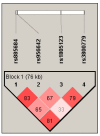Two four-marker haplotypes on 7q36.1 region indicate that the potassium channel gene HERG1 (KCNH2, Kv11.1) is related to schizophrenia: a case control study
- PMID: 20507645
- PMCID: PMC2890623
- DOI: 10.1186/1744-9081-6-27
Two four-marker haplotypes on 7q36.1 region indicate that the potassium channel gene HERG1 (KCNH2, Kv11.1) is related to schizophrenia: a case control study
Abstract
Background: The pathobiology of schizophrenia is still unclear. Its current treatment mainly depends on antipsychotic drugs. A leading adverse effect of these medications is the acquired long QT syndrome, which results from the blockade of cardiac HERG1 channels (human ether-a-go-go-related gene potassium channels 1) by antipsychotic agents. The HERG1 channel is encoded by HERG1 (KCNH2, Kv11.1) gene and is most highly expressed in heart and brain. Genetic variations in HERG1 predispose to acquired long QT syndrome. We hypothesized that the blockade of HERG1 channels by antipsychotics might also be significant for their therapeutic mode of action, indicating a novel mechanism in the pathogenesis of schizophrenia.
Methods: We genotyped four single nucleotide polymorphisms (SNPs) in 7q36.1 region (two SNPs, rs1805123 and rs3800779, located on HERG1, and two SNPs, rs885684 and rs956642, at the 3'-downstream intergenic region) and then performed single SNP and haplotype association analyses in 84 patients with schizophrenia and 74 healthy controls after the exclusion of individuals having prolonged or shortened QT interval on electrocardiogram.
Results: Our analyses revealed that both genotype and allele frequencies of rs3800779 (c.307+585G>T) were significantly different between populations (P = 0.023 and P = 0.018, respectively). We also identified that two previously undescribed four-marker haplotypes which are nearly allelic opposite of each other and located in chr7:150225599-150302147bp position encompassing HERG1 were either overrepresented (A-A-A-T, the at-risk haplotype, P = 0.0007) or underrepresented (C-A-C-G, the protective haplotype, P = 0.005) in patients compared to controls.
Conclusions: Our results indicate that the potassium channel gene HERG1 is related to schizophrenia. Our findings may also implicate the whole family of HERG channels (HERG1, HERG2 and HERG3) in the pathogenesis of psychosis and its treatment.
Figures




References
Publication types
MeSH terms
Substances
LinkOut - more resources
Full Text Sources
Other Literature Sources
Medical

